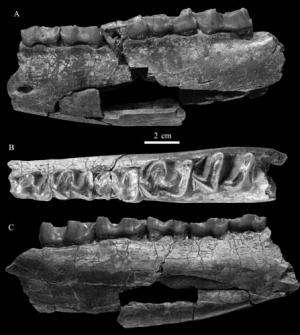New species of Eggysodontid found from the Paleogene of the Guangnan Basin, Yunnan, China

Eggysodontid is a group of extinct rhinocerotoid animals of odd-toed ungulate. Rhinocerotoid fossils are relatively abundant in Paleogene deposits in South China. Many previous studies have investigated Paleogene rhinocerotoids from Yunnan Province. In an article published in the latest issue of Vertebrata PalAsiatica 51(4), Dr. WANG Yuan-Qing, Institute of Vertebrate Paleontology and Paleoanthropology (IVPP), Chinese Academy of Sciences, and his team reported a new genus and species of eggysodontids, Guangnanodon youngi, from the Paleogene of the Guangnan Basin, Yunnan Province, China. This new species is the first occurrence of eggysodontids in South China, providing new material for studying the evolution and biogeography of eggysodontids.
The holotype of Guangnanodon youngi is a fragmented left mandible with p3-m3. It was found from the Paleogene Yanshan Formation at Xiaoguangnan Village, Liancheng Town, Guangnan County, Yunnan Province, China.
The lower molars of Guangnanodon are evidently characteristic of Eggysodontidae in their overall morphology. However, it differs from all three reliably established genera in the family in having moderately molarized lower premolars (p3-p4). Previously known Asian eggysodontids include the Late Eocene Proeggysodon and the Oligocene Allacerops. Guangnanodon is more derived than Proeggysodon in being larger and in having more extensively molarized lower premolars with relatively complete entolophids on p3-p4.
The moderately molarized lower premolars of Guangnanodon suggest that this taxon is probably intermediate in age between Proeggysodon on the one hand and Eggysodon and Allacerops on the other. In Asia, Proeggysodon was unearthed in Upper Eocene sediments, while Allacerops is from the Lower Oligocene. The oldest specimens of Eggysodon are from the lowermost Oligocene (MP1) of Europe. Accordingly, Guangnanodon is probably latest Eocene in age, making it younger than the other specimens from the Guangnan Basin. Accordingly, the Yanshan Formation, at least, contains sediments of ages that range from late Middle Eocene to latest Eocene.
Journal information: Vertebrata PalAsiatica
Provided by Chinese Academy of Sciences





















